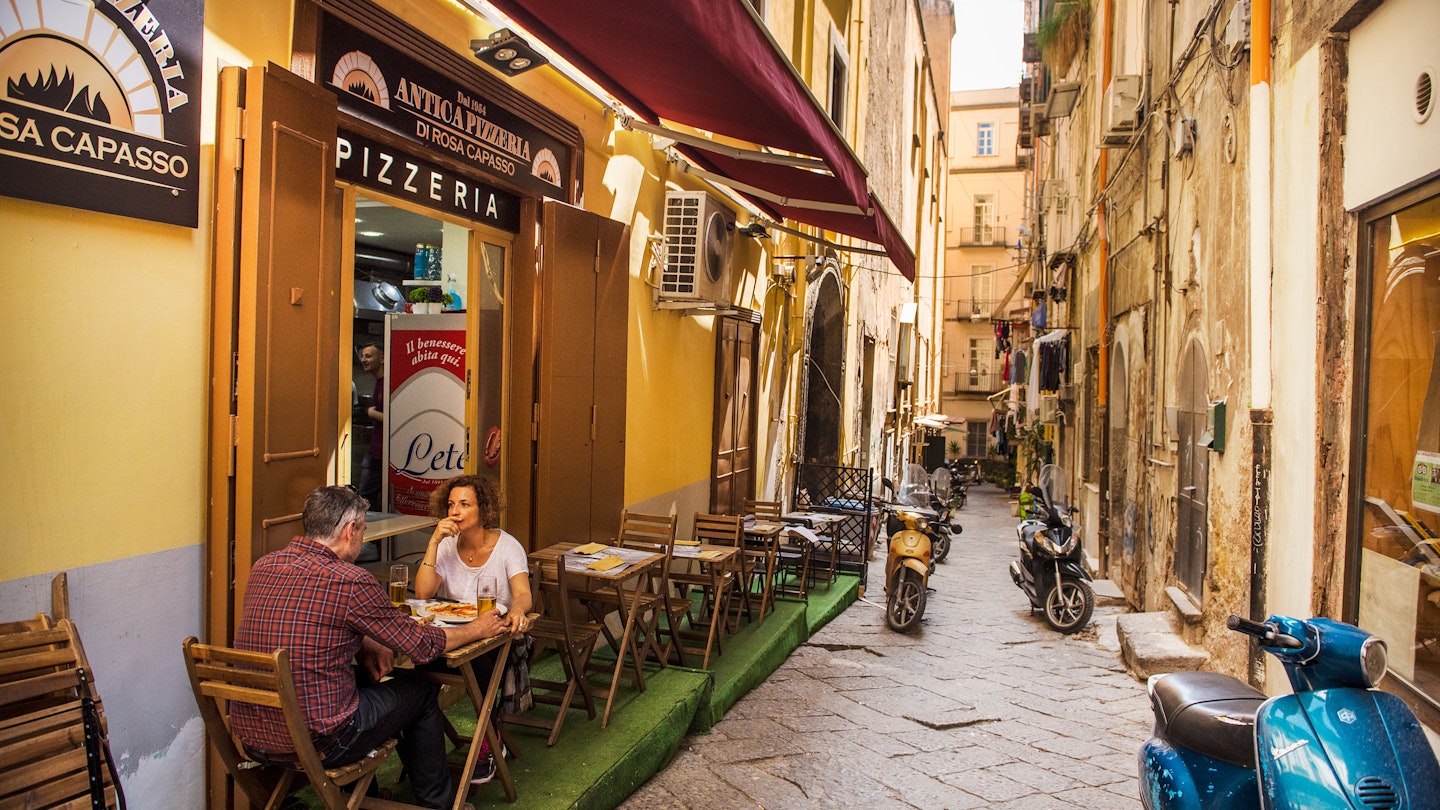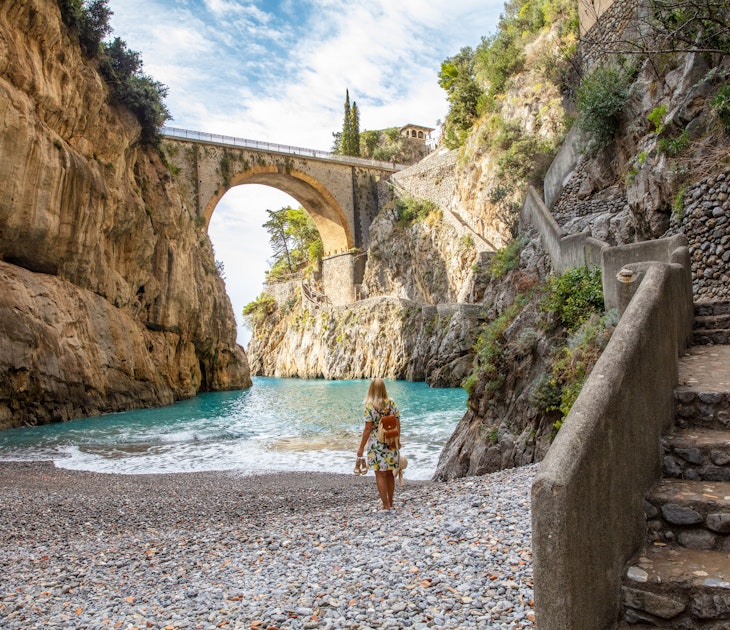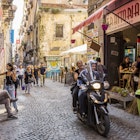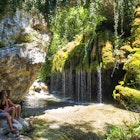As Italian cities go, sun-scorched Naples offers great value for visitors.
And as cities go within Western Europe, the teeming port city in southern Italy promises an even finer deal for travelers seeking a maximum bang for their limited buck. For it’s the very streets from which this ancient Greek settlement is stitched that constitute the main attraction of this raw, raucous, high-energy town.
With insider tips and careful planning, budget-conscious travelers can lap up the very best of Italian dolce vita – Vespa-charged street life, aria-inspiring vistas, soul-soaring art and pizza in spades – without breaking the bank. Here’s how to maximize each euro and enjoy Naples on a budget.
Avoid high season
The shoulder seasons – late spring and early fall – are the most affordable times to visit Naples. In April, June, September and October hotels, guesthouses and self-catering accommodation across the board lower their nightly rates, with many offering truly excellent deals on advance bookings.
Other shoulder-season perks include no queues at big sights and no crowds on the beach. We highly recommend timing your trip to coincide with one of the many tasty annual (and usually free) festivals that celebrate everything from sweet late-spring apricots nurtured in the volcanic soils of Mt Vesuvius to the autumnal grape and fig harvests.
Low season (November to March) is the cheapest time to explore Naples. The most eager budget travelers can leave the sunscreen at home and tuck into festive Christmas and Carnevale culinary and cultural festivities instead, at a snip of high-season prices. Accommodation rates can be up to 30% lower than in the most popular months.
Check into a good-value guesthouse or hostel
Budget-oriented hostels, alongside B&Bs and small guesthouses, offer the cheapest accommodation types in Naples. Many B&Bs and guesthouses are squirreled away in the back alleys of working-class neighborhoods Quartieri Spagnoli and La Sanità; run by artists or artisans, they provide a privileged insight into daily life in Neapolitan bohemia. Be sure you balance your budget against your own personal safety, however, as some parts of both neighborhoods can feel sketchy and well out of the comfort zone of some visitors.
Hostels tend to be more centrally located and reassure with safety in numbers, shared kitchens and regular social events. In the dead-central centro storico, Neapolitan classic Hostel of the Sun enjoys an upbeat social vibe, while Hostel Mancini builds community through weekly group dinners. Perks like the complimentary Thursday-evening aperitivo (aperitif) offered at Hostel Mancini, or the free food that comes with purchased cocktails at new-school hostel La Controra, make such addresses better value still.
Live like a local in a short-term rental
For budget travelers in Naples for more than two nights, short-term rentals are a great option – especially for families, or if you’re traveling as a couple or in a small group. Rentals range from terraced attics overlooking the medieval old town, to high-ceilinged rooms in Liberty-style palazzi with Bay of Naples views, to uber-Neapoltian basso apartments (ground-floor units traditionally tucked down tiny cobbled alleys in the Quartieri Spagnoli).
When booking self-catering rentals, try to favor local Neapolitan accommodation agencies and home-sharing platforms that give something back into the community (here’s hoping Fairbnb comes to Naples soon), rather than than big global players. The official Visit Naples tourism bureau runs an accommodation service that’s a good starting point.
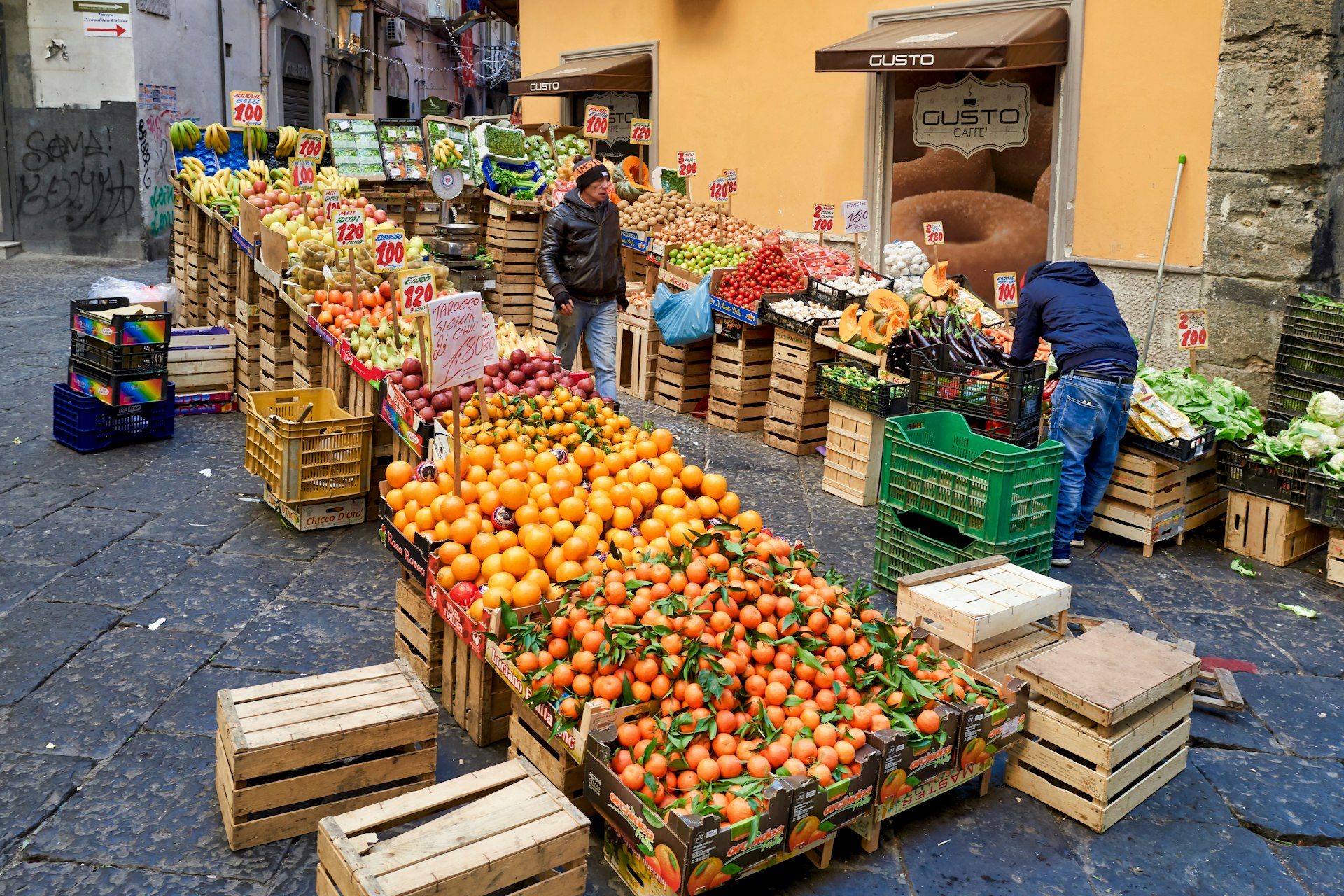
Shop for picnics and other meals at the market
Food shopping at La Pignasecca or another of Naples’s fabulous open-air markets lets you economize for meals while enjoying one of the city’s greatest pleasures. Pick up fixings for breakfast and evening meals if you’re in self-catering digs; delicious lunchtime picnics and snacks to accompany your very own DIY version of that all-essential aperitivi (aperitif) await those staying in hotels and guesthouses.
Market shopping not only allows you to cook insalata di Napoli (Neapolitan salad, laced with local buffalo-milk mozzarella) or spaghetti alla puttanesca (“whore’s spaghetti,” with tomatoes, olives, capers and anchovies) at home for a snip of any restaurant price. A visit to the market stalls is also a prime opportunity to rub shoulders with locals, strike up conversations with vendors, and see with your own eyes exactly which fresh, zero-kilometer produce is in season (and, in turn, the seasonal dishes you should be favoring when dining out).
Top tip: you’ll find some of the city’s most authentic, grassroots trattorias in the streets immediately adjacent to the market.
Save money sightseeing with a discount card
If you’re in town to see as many sights as you can in a few days, the Campania Artecard is worth the investment. Buy it online, with the >artecard app, or at any participating museum or monument.
The cumulative ticket covers museum admission and transport, and comes in various forms. The three-day Naples card (€21) provides free admission to three absolutely must-see sights: one of the world’s finest collections of Graeco-Roman artifacts at the Museo Archeologico Nazionale; Southern Italy’s richest art gallery, Museo di Capodimonte; and Naples’s oldest catacombs, Catacombi di San Gennaro. The pass also offers up to 50% off tickets to other attractions, plus free use of public transport within the city limits.
To enjoy blockbuster sites a bit farther afield, opt for the three-day Campania version (€32), which includes admission Pompeii and Herculaneum, 50% off other regional attractions, and public-transport fares as far afield as Caserta, Ravello (Amalfi Coast) and Paestum.
Cheaper youth versions of both cards (Naples €12/Campania €25) are a brilliant deal for visitors aged 18 to 25, as they cover public transport and free admission to a staggering 10 and 30 sites, respectively.

Ditch public transport for the passeggiata
To be part of the local crowd, walk.
While the city is serviced by an affordable network of public buses (handy for Capodimonte with its grandiose royal palace and park), a trio of funiculars up to Vomero, a metro network and suburban trains, Naples is compact, has contiguous neighborhoods and almost begs to be navigated on foot. Fully immersing yourself in the city center’s intoxicating street sights, sounds and smells as you wander is always gratis.
One note: come late afternoon, don’t be surprised to be joined by throngs of locals. The traditional passeggiata (early-evening stroll) is sacrosanct for all Neapolitans.
Drink coffee standing up
As in every Italian city, an espresso shot enjoyed standing up at the bar is notably cheaper than sitting down at a table. If you’re lucky, you might even strike up conversation with a local while you linger after caffeinating.
Read up on sights offering free admission
Since a little research goes a long way, plot out a walking itinerary of city sights that don’t require an admission fee. Begin in the history-charged centro storico (historic center) and its Unesco World Heritage–listed main street, Spaccanapoli. Along the way, stop into sublime churches that brim with sacred art: Chiesa del Gesù Nuovo, the basilica at Complesso Monumentale di Santa Chiara, Chiesa di San Domenico Maggiore, the hauntingly beautiful Chiesa e Chiostro di San Gregoriio Armeno, the spectacular cathedral… and that’s just for your first afternoon.
Other iconic sights to build into any “free admission” itinerary include Castel dell’Ovo, the ghoulish graveyard Cimitero delle Fontanelle and the palatial gardens and grounds of Bourbon monarch Charles VII’s former hunting “lodge.”
Panoramic views from the city’s hilly green spaces and the sensational gallery of edgy metro art displayed in the city’s transit stations offer superb stimulation for budget-conscious travelers. If you don’t have the will or energy to DIY, join a free organized walking tour with Free Walking Tour Napoli (with a tip for your dedicated local guide much appreciated).
Rendez-vous at Naples’s spectacular national library
A city highlight for bibliophiles and culture lovers, the city’s often-overlooked Biblioteca Nazionale di Napoli occupies part of the historic Palazzo Reale. Among its priceless treasures are fragments of a 5th-century Coptic Bible and thousands of ancient papyri uncovered at Herculaneum.
Free visits are by advance reservation only. If you don’t get your act together in advance, pop in regardless to enjoy a moment of serenity in the swoon-worthy Biblioteca Lucchesi Palli on the library’s second floor, a 19th-century masterpiece by some of the era’s most skilled artisans.
Eat pizza
Wood-fired pizza is Naples’s most famous export. So tucking into a thin-based, raised-crust pizza napoletana at Pizzeria Starita or Da Michele might be as aesthetic a Neapolitan experience as viewing Giuseppe Sanmartino’s Cristo Velato sculpture in the baroque Cappella Sansevero.
Best of all, pizza here is highly affordable and the perfect fuel for budget-conscious visitors. You’re sure to find the cheapest option, a pizza margherita (topped with tomato sauce and cheese) on every pizza menu.
To taste the real thing, look for signs reading “vera pizza napoletana” to ensure real or authentic Neapolitan preparations. Avoid restaurants touting English-language menus – or (heaven forbid) a faux plastic pizza on a plate displayed on the street outside as a lure for tourists. Finally, don’t feel obliged to buy an entire pizza: go for “pizza al taglio” (pizza by the slice) to take away and eat in a nearby piazza or park.
Avoid the seasonal express train to Pompeii
Budget travelers counting every last cent should take the lead of locals and catch a suburban Circumvesuviana train (follow signs from Napoli Centrale station on Piazza Garibaldi) to the world-famous archeological sites of Pompeii and Herculaneum.
Seasonal Campania Express trains, departing from the same Circumvesuviana station at Napoli Centrale, are geared towards the summer tourist crowd. While the journey time is practically the same as a locals-oriented option (33 minutes instead of 38 minutes), fares are higher (€15 return instead of €6.40).
Make day trips of the islands
Sprinkled like multi-colored confetti in the bright blue Bay of Naples, the islands of the Amalfi Coast are justifiably famous and sought-out. Tiny, tranquil Procida is an unspoiled blend of sun-bleached lanes and pastel-hued harbors. Cliff-chiseled Capri, off the west end of the Sorrento Peninsula, seduces with its celebrity circuit of manicured villas, lush gardens and luxury shopping. Ischia is well-endowed with natural spas, botanical gardens, hidden coves and more picture-perfect spots.
But such extraordinary beauty comes at a price, and accommodation on all three islands is the preserve of the super-rich. Day trips from Naples are the most affordable way of experiencing these places’ many pleasures.

Take the slow boat
Cut travel costs to Procida, Capri and Ischia by catching a slower ferry from Naples’s Porta di Massa (also known as Molo Beverello), in front of Castel Nuovo. While speedier hydrofoils likewise depart from Porta di Massa as well as Marina Granda, they’re pricier.
The difference in journey time is generally no more than 30 minutes, and with cinema-worthy views to gasp at from the deck during the scenic voyage, who cares?
Get to the stazione marittima (ferry port) with ample time to spare. This will give you the flexibility to study the ferry schedule and identify the best deal: even among the ferries, faster and slower ferries command different fares. Slow-ferry operators include Caremar and Medmar.
Once on the islands, use your own two feet, a bicycle or public buses to get around. There’s absolutely no need to fork out cash on a car hire – much less pay to take your own vehicle across on a car ferry.

Feast on Naples’s brilliant street-food scene
The narrow, laundry-garlanded streets of Naples are awash with authentic pizzerias, historic pastry shops and family-run “fast-food” outlets cooking up bona fide street food that puts every global chain to shame.
Be it a traditional pizza margherita from old-school Di Matteo, pizza-dough buns stuffed with artichoke from new-school Concettina Ai Tre Santi or superlative pizza fritta (fried pizza) at Antica Pizza Fritta da Zia Esterina Sorbillo, there really is no end to the brilliant, cheap and tasty street-food scene and “fast food” dining here.
Footnote: do not skimp on dolci (dessert). Classic sfogliatella (ricotta-filled pastries) from Pintauro, runny rummy baba from retro pastry chef Attanasio and Pasticceria Mennella’s frolla al limone (shortbread pastry with lemon cream) and highly addictive gelato hit the (sweet) spot admirably.
Find ways to volunteer
Naples’s rich history, heritage and abundance of precious art treasures are but one layer of a city that contains many cultures and its share of underprivileged areas. To go beyond the glossy tourist track and experience Napoli from a very different perspective while traveling on a budget, seek out opportunities to volunteer.
Helping out in shelters, schools and sports centers in Naples’s refugee and migrant communities, teaching English, or getting your hands dirty in a protected marine park are but three ways visitors can really get to know this town without spending a fortune.
There are dozens of local volunteering organizations with connections throughout the city. International Napoli Network makes an excellent starting point.
Daily costs in Naples
Shuttle bus from Naples-Capodichino Airport: €5 ($5.70)
Hostel dorm bed: €15–30 ($17–34)
Budget hotel room for two: €40–100 ($45.50–114)
Self-catering apartment for two: €30–50 ($34–57)
Pizza: €4–15; slice €1–2 ($4.50–17; $1.10–2.20)
Metro or bus ticket: €1.50 ($1.70)
Espresso at the bar/a table: €2/4 ($2.30–4.50)
Dinner for two with drinks: €30–50 ($34–57)
Spritz aperitivi: €1–5 (1.10–5.70)
You might also like:
The best free things to do in Naples: fun activities that won't cost a penne
The best things to do in Naples: livin' la dolce vita
Getting around Naples is easy with these top tips

